Idea
Our idea came from the third story, called The Plague written by Yan Leisheng. For a little bit of background information, the setting takes place in a drastic apocalyptic society. Here, a deadly plague that turns people to stone is depopulating the planet. The main character’s role in this society is a Crow, or “the vulgar name common people gave us. Our biohazard suits were black instead of the normal white, and we were harbingers of death, like crows” (Leisheng). His job is to burn anyone who is turned into stone, and the bizarre story takes a spin from there.
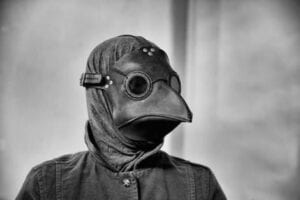
Brainstorm
After talking with our group members (Morgan, Shake, Frida, & Maryam), we decided on Morgan’s idea. He wrote the following innovative idea for his assignment:
- My interactive artifact would be an interactive bed where patients lie down, and a holographic schematic of their bodies’ autonomy appears above them. It would also highlight where an infection may be centralized in the body and propose remedies for various illnesses based on the nature of the diagnosis.
At first, we thought about creating this piece. However, we realized it would be too large and basic to replicate. Later on, we learned that Morgan had previously crafted cardboard projects at a young age! Using his expert knowledge, we took this into consideration and continued to brainstorm our plans. Eventually, we decided on an iron-man-inspired technological advanced arm. This highly functional & detail-orientated arm would be able to scan people for any signs of the stone virus. If they don’t have signs of it, patients would simply move on. Though, the gadget would analyze and process the information, then save it to a mass government database. If patients do observe any signs on the sensor, they are immediately taken for further examination and ‘burning’ if necessary. This can oddly be viewed as our green/red codes, with the arm scanner replacing the typical phones Covid officials use to scan. The arm sensor was inspired by the device in Fallout 4. Therefore, we would later draw that on the cardboard as an easter egg. With all that being said, let’s begin designing! Actions speak louder than words!
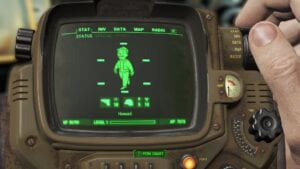
Designing
The idea was imaginative, but the problem at hand is the execution. It’s extremely difficult to build such a sophisticated product from scratch, especially with most of our group having limited experience. Fortunately, Morgan guided our team to a website that he used in the past! Called Pepakura Designer, this website creates fold patterns that paper/cardboard can use. This not only gave us a guide to follow, but the exact measurements to make the design intricate. Next, our team began to print, cut, and fold the printed paper. We proceeded to transfer the paper version onto cardboard. During this process, we had to pick/choose the best quality in the remaining scrap cardboard obtainable!
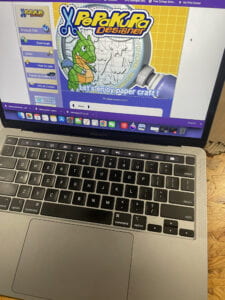
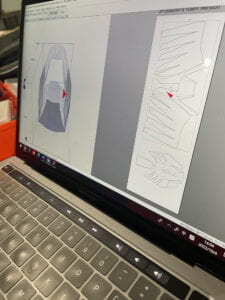
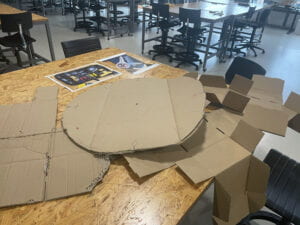
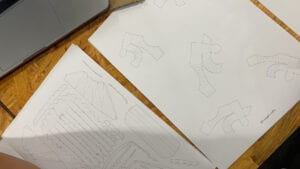
Designing Cont.
At this point, we were still in the process of designing the piece. We talked about our project details, what to perform, & just getting to know each other! Everyone worked very diligently, and a warm bond was created. Little by little, we began to piece each of the components together.
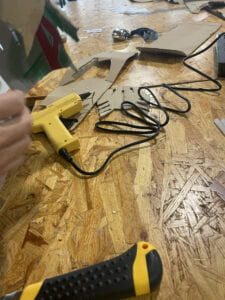
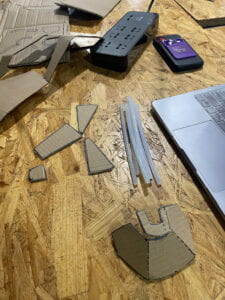 .
. 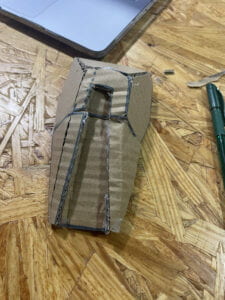
Finished Design
After nearly four productive hours, our work was finally complete! During the process, I witnessed Morgan cutting the cardboard itself. Later, he explained it allowed the cardboard to be easier to fold. The rest of our group collectively grasped this fact and began to attempt it ourselves! I was very satisfied with how the final result turned out. Each of the three separate parts (hand shield, forearm, arm), combined together by hot glue, allowed the arm to shape. We even added a hinge system, which pulled out and retracted when toggled. On the arm, we drew a digital camera and the fallout sensor (as mentioned above)! Overall, making the creation itself was very tedious. However, I believed the hard work paid off and we had a beautiful product!
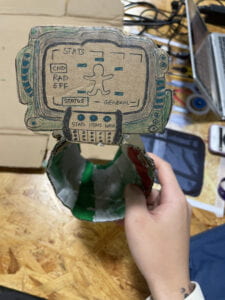
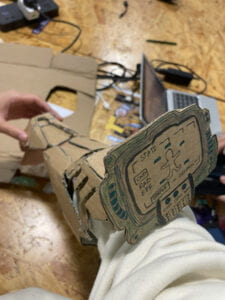
Rehearsing
Finishing out the product, we began rehearsing for the actual performance! Though, there were some difficulties. In our group, there were freshmens, sophomores, and a senior. Therefore, our schedule was scattered everywhere. We ultimately decided on a suitable time that worked for everyone. In total, we held around 2-3 rehearsals. The first rehearsal was very messy and unorganized. This is due to the fact that there was no script, and raw ideas were being pushed everywhere. Later, I ended up writing the role script for the team. By doing this, I strongly believed that everyone can learn and remember their lines faster. Before the actual performance, we directly rehearsed in the 826 room. This made us feel prepared and less nervous about what was to come! Overall, I think this was a great communication and cooperation activity that we pulled off well (unfortunately, there is no footage of the rehearsals as our group performed until everyone left).
Performance
Before the performance, we had already practiced frequently. However, one of our members had classes back to back that day and was unable to make it to the final rehearsal. I was a little worried, but I had previously known this. As a result, I assigned her the more straightforward role of a Crow. The other Crow, Frida, successfully remembered both of the Crow’s lines. This meant that she was capable of intercepting and improv-ing if needed (was not needed). I even went to Student Life and borrowed a prop (1000 TON hammer)! Within ourselves, we decided to go first to get the anxiety over with. Below, I will attach the full video of our performance! Personally, I think we did fantastically. Not only me, but our entire group excelled and acted their very best. I was the beginning narrator, as I wanted to make sure that the storyline was projected loud enough to the audience. My group members were usually quiet and soft-spoken. However, when it counted, they spoke confidently loud and clear to their respective viewers!
Little improv was needed, as everyone stuck with their original script. I would say the only throw-off would be the space available, as the tape restricted us from moving freely. We incorporated a moral theme in the story and interacted with the audience themselves. In the story, the Crow kills the civilians. Seeking revenge, we could’ve let that plan succeed. However, the group decided that this ending was anticlimatic and predicted. Therefore, refusing to kill the Crows, in the end, was the correct decision. When the Professors and audience asked questions, I felt that our group was able to successfully answer all of them with ease. There was rarely any hesitation or pause when answering, as we’ve previously trained for any unexpected questions that may appear. In conclusion, I loved this project! It was creative, intuitive, and interactive.
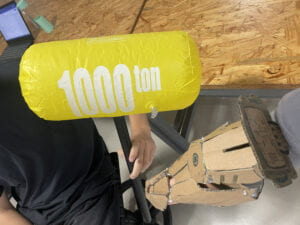
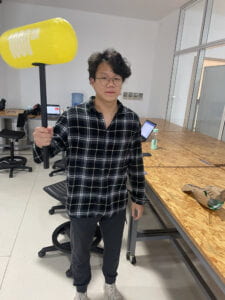 .
. 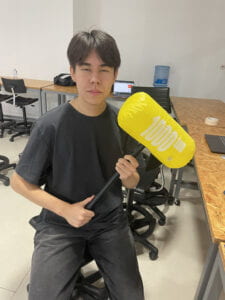
Additional Comments
In the performance, our device served as a high-tech sensor that could instantly detect and differentiate stone people from non-stoned. When it came to Morgan, we presented a moral dilemma to the audience. He was only half-stoned, but this meant nothing to the duty-orientated Crows. The hammer served as the primary weapon, with different cast and scenes being enacted. For improvements, I believe that we should’ve better shown the camera and hinge system in action. We carefully designed them but didn’t use them in the main performance. I think this not only would’ve awed the audience, but showed how advanced our technology was. For my role, I served as a ‘leader’ who guided the group into different directions and acted as a time manager. I wrote the script, directed people, & explained anything that seemed unclear! But, this is not to discredit any of my teammates. I think they all respectfully did well, and deserve their applause! Everything went smoothly, apart from the schedule difference. Throughout the process, we all encouraged and motivated each other to work and practice. I’m content with the work, whether artifact-wise or performance-wise.
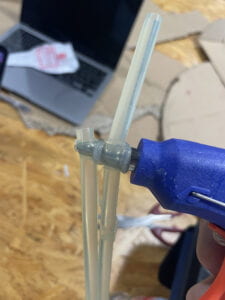
(featuring my stuck hot-glue gun…)
Critical Analysis of Lesley’s Group
Personally, I enjoyed everyone’s presentations. They were all organized and carefully practiced. However, I would definitely have to choose Lesley’s group (I’m referring to this name because I do not remember their group name :/ ) to be my personal favorite. In this performance, everyone played a role. Lesley served as the patient, with doctors and nurses around him. Then, they attached a VR helmet and gloves to him. Suddenly, the migraine that he had miraculously disappeared. He imagined a beach and instantly teleported to one.
From there, the other members actively moved around the painted pieces of cardboard they had. At a glance, it almost seems like the sun/clouds are moving and have a will of themselves (reminds me of a soul-eater reference). I believe that they fit the criteria of the assignment, while also being relevant to the original story. The original story depicts a VR room that could switch settings on command, which is very similar to their creation. During the question round, I asked whether users of this device could enjoy a first-class meal. The group responded cleverly with the statement that “you can visually, but there won’t be any taste”. A minor improvement I would say is that they could’ve tried swapping scenarios. For example, Lesley (the patient) could be switched to another country. From there, new cardboard could be put which reveals another scenario. Overall, I believe that this group stayed with the requirements and performed well. It was believable and there weren’t any visible lags. The cardboard piece itself was also painted, which added color and personality to the otherwise dull-looking material.

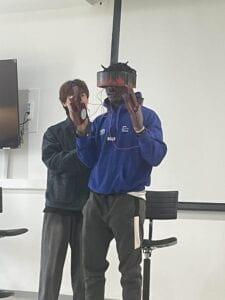
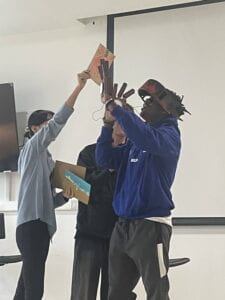
Leave a Reply